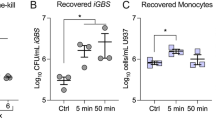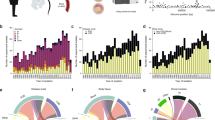Abstract
ABSTRACT: The meningeal inflammatory response to a heat-killed mutant unencapsulated strain of type III group B Streptococcus (GBS) was studied in a newborn piglet model. GBS (109 colony-forming unit equivalents) or saline (control) was inoculated intraventricularly. Serial cerebrospinal fluid measurements were done at baseline and over the course of the next 24 h for cytochemical changes and production of tumor necrosis factor (TNF) and prostaglandins. In separate experiments, we defined the time course of early changes during the first 6 h and dose response relationship over a range of inocula 106 to 109 colony-forming unit equivalents. The intraventricular inoculation of the heat-killed unencapsulated GBS induced marked leukocytosis and increased protein by 6 h. These changes were preceded by a several hundredfold increase in TNF (maximum at 2 h) and prostaglandins (maximum at 2–4 h). The early and sharp rise in TNF suggests its pivotal role in initiating the inflammatory cascade. The magnitude of the inflammatory response increased with increasing bacterial dose over the range studied. To study the effect of encapsulation of GBS in the induction of meningeal inflammation, we compared the response to the unencapsulated mutant strain with that to the encapsulated parent strain. The encapsulated strain produced much smaller inflammatory changes, and only with high doses of bacteria. The GBS cell wall appeared to be the primary bacterial product triggering inflammation. Intraventricular injection of the heat-killed unencapsulated GBS with exposed cell wall can serve as a valid model for studying neonatal meningitis.
Similar content being viewed by others
Log in or create a free account to read this content
Gain free access to this article, as well as selected content from this journal and more on nature.com
or
Author information
Authors and Affiliations
Rights and permissions
About this article
Cite this article
Ling, E., Noya, F., Ricard, G. et al. Biochemical Mediators of Meningeal Inflammatory Response to Group B Streptococcus in the Newborn Piglet Model. Pediatr Res 38, 981–987 (1995). https://doi.org/10.1203/00006450-199512000-00025
Received:
Accepted:
Issue date:
DOI: https://doi.org/10.1203/00006450-199512000-00025



